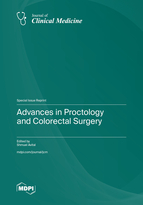Advances in Proctology and Colorectal Surgery
A special issue of Journal of Clinical Medicine (ISSN 2077-0383). This special issue belongs to the section "General Surgery".
Deadline for manuscript submissions: closed (20 June 2023) | Viewed by 31777
Special Issue Editor
2. Sackler Faculty of Medicine, Tel Aviv University, Tel Aviv 6997801, Israel
Interests: surgical oncology; colon cancer; rectal cancer; robotic surgery; IBD
Special Issues, Collections and Topics in MDPI journals
Special Issue Information
Dear Colleagues,
Recent years have seen major changes in the treatment and surgical approach to colorectal pathologies. These changes were driven by technological developments, changes in concepts regarding treatment options and the movement towards personalized treatment.
Technological progress has led to a gradual adoption of robotic surgery for colorectal resections, the use of trans-anal microsurgery and advanced laparoscopic use.
Conceptual changes can be seen in several fields, such as in IBD when upfront surgery in limited disease of Chron's patients became a valid option, or in the growing use of total neoadjuvant treatment for patients with rectal cancer to achieve a complete response in order to avoid surgery on one hand and upfront surgery without preoperative irradiation in other patients on the other. As a further example, progress in the research of stem cells has led to their use in anorectal diseases such as perianal fistulas and fissures.
These are only few examples of the vast progress seen in colorectal surgery and proctology in recent years.
The aim of this Special Issue is to provide a platform for the presentation of recent research regarding advances in proctology and colorectal surgery.
Prof. Dr. Shmuel Avital
Guest Editor
Manuscript Submission Information
Manuscripts should be submitted online at www.mdpi.com by registering and logging in to this website. Once you are registered, click here to go to the submission form. Manuscripts can be submitted until the deadline. All submissions that pass pre-check are peer-reviewed. Accepted papers will be published continuously in the journal (as soon as accepted) and will be listed together on the special issue website. Research articles, review articles as well as short communications are invited. For planned papers, a title and short abstract (about 100 words) can be sent to the Editorial Office for announcement on this website.
Submitted manuscripts should not have been published previously, nor be under consideration for publication elsewhere (except conference proceedings papers). All manuscripts are thoroughly refereed through a single-blind peer-review process. A guide for authors and other relevant information for submission of manuscripts is available on the Instructions for Authors page. Journal of Clinical Medicine is an international peer-reviewed open access semimonthly journal published by MDPI.
Please visit the Instructions for Authors page before submitting a manuscript. The Article Processing Charge (APC) for publication in this open access journal is 2600 CHF (Swiss Francs). Submitted papers should be well formatted and use good English. Authors may use MDPI's English editing service prior to publication or during author revisions.
Keywords
- surgical oncology
- colon cancer
- rectal cancer
- anorectal diseases
- robotic surgery







